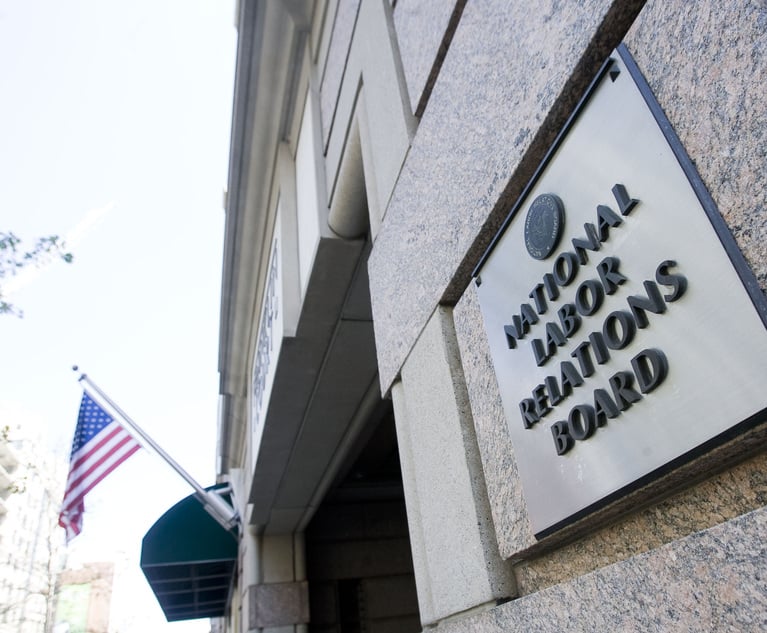 Credit: Shutterstock.com
Credit: Shutterstock.com4th Circuit Case on Blended Rate Is Lesson in Record-Keeping
The appellate panel held that Fire & Safety Investigation Consulting Services and its owner, Christopher Harris, did not keep adequate records and violated the Fair Labor Standards Act by failing to pay overtime to certain employees.
February 21, 2019 at 11:18 AM
3 minute read
A recent U.S. Court of Appeals for the Fourth Circuit decision concerning the Fair Labor Standards Act and overtime pay has employment law experts saying this is a cautionary tale for companies trying to pay their employees at a blended rate.
The appellate panel held earlier this month that Fire & Safety Investigation Consulting Services LLC and its owner, Christopher Harris, did not keep adequate records and violated the FLSA by failing to pay overtime to certain employees in Pennsylvania and West Virginia. The U.S. Department of Labor had filed suit in February 2017 against Fire & Safety over the allegations as the U.S. District Court for the Northern District of West Virginia ordered Fire & Safety last May to pay back wages and damages totaling $1.6 million.
Fire & Safety did not immediately respond to a request for comment. The company was represented by Joseph Lawrence Amos Jr. of Miller & Amos in Charleston, West Virginia. Amos did not respond to a request for comment. The Labor Department did not respond to a request for comment.
Debra Steiner Friedman, a member at Cozen O'Connor in Philadelphia, said she believes the panel made the correct decision.
“I believe that the court correctly applied the law and I believe it's a lesson for employers,” Friedman said.
Generally, employers are looking for the easiest way to administer their payroll, Friedman said, and if they believe there is a way for easier administration, they may be tempted to have a blended kind of compensation.
“Here the idea of saying we're going to pay you a fixed rate for a fixed number of hours is totally appropriate as long as that fixed rate is based on the number of straight time hours and the number of overtime hours worked,” Friedman said.
Friedman said that kind of payment goes astray for situations where it is not a fixed number of hours.
“They were trying to, in my opinion, use a shortcut,” Friedman said.
Charles McDonald, a shareholder at Ogletree, Deakins, Nash, Smoak & Stewart in Greenville, South Carolina, said anytime an employer tries to incorporate a regular rate and an overtime rate into a fixed amount of pay for hours worked, the employer needs to be careful.
“They are in essence saying, 'This is the hourly rate and this is the overtime rate.' And if they do something inconsistent with that, the Department of Labor is going to say, 'No, that wasn't really the regular rate, the true regular rate is the total of wages divided by the number of hours worked.'”
McDonald said companies can pay a fixed rate that includes both overtime and fixed time, but they have to be clear on what the rate is.
“It has to be spelled out and then you have to actually follow those figures when people work less than what the fixed amount is supposed to cover,” McDonald said. “If you don't, the Department of Labor will say it's all a sham and the real hourly rate or the regular rate is whatever the blended rate is.”
The case is also a lesson in proper record-keeping.
“Part of the problem here is that the employer wasn't keeping proper records,” Friedman explained. “For these employees you need to keep records for the number of hours worked per day and per week.”
This content has been archived. It is available through our partners, LexisNexis® and Bloomberg Law.
To view this content, please continue to their sites.
Not a Lexis Subscriber?
Subscribe Now
Not a Bloomberg Law Subscriber?
Subscribe Now
NOT FOR REPRINT
© 2025 ALM Global, LLC, All Rights Reserved. Request academic re-use from www.copyright.com. All other uses, submit a request to [email protected]. For more information visit Asset & Logo Licensing.
You Might Like
View All
NLRB Blisters Skilled Care Home Chain That Terminated Nursing Assistant Who Complained About Wages
6 minute read
Preparing for 2025: Anticipated Policy Changes Affecting U.S. Businesses Under the Trump Administration

Employers Race to File NLRB Petitions to Gain Upper Hand in Union Organizing
5 minute readTrending Stories
- 1The Quiet Revolution: Private Equity’s Push Into Law Firms
- 2Restoring Trust in the Courts Starts in New York
- 3'Pull Back the Curtain': Ex-NFL Players Seek Discovery in Lawsuit Over League's Disability Plan
- 4Tensions Run High at Final Hearing Before Manhattan Congestion Pricing Takes Effect
- 5Improper Removal to Fed. Court Leads to $100K Bill for Blue Cross Blue Shield
Who Got The Work
Michael G. Bongiorno, Andrew Scott Dulberg and Elizabeth E. Driscoll from Wilmer Cutler Pickering Hale and Dorr have stepped in to represent Symbotic Inc., an A.I.-enabled technology platform that focuses on increasing supply chain efficiency, and other defendants in a pending shareholder derivative lawsuit. The case, filed Oct. 2 in Massachusetts District Court by the Brown Law Firm on behalf of Stephen Austen, accuses certain officers and directors of misleading investors in regard to Symbotic's potential for margin growth by failing to disclose that the company was not equipped to timely deploy its systems or manage expenses through project delays. The case, assigned to U.S. District Judge Nathaniel M. Gorton, is 1:24-cv-12522, Austen v. Cohen et al.
Who Got The Work
Edmund Polubinski and Marie Killmond of Davis Polk & Wardwell have entered appearances for data platform software development company MongoDB and other defendants in a pending shareholder derivative lawsuit. The action, filed Oct. 7 in New York Southern District Court by the Brown Law Firm, accuses the company's directors and/or officers of falsely expressing confidence in the company’s restructuring of its sales incentive plan and downplaying the severity of decreases in its upfront commitments. The case is 1:24-cv-07594, Roy v. Ittycheria et al.
Who Got The Work
Amy O. Bruchs and Kurt F. Ellison of Michael Best & Friedrich have entered appearances for Epic Systems Corp. in a pending employment discrimination lawsuit. The suit was filed Sept. 7 in Wisconsin Western District Court by Levine Eisberner LLC and Siri & Glimstad on behalf of a project manager who claims that he was wrongfully terminated after applying for a religious exemption to the defendant's COVID-19 vaccine mandate. The case, assigned to U.S. Magistrate Judge Anita Marie Boor, is 3:24-cv-00630, Secker, Nathan v. Epic Systems Corporation.
Who Got The Work
David X. Sullivan, Thomas J. Finn and Gregory A. Hall from McCarter & English have entered appearances for Sunrun Installation Services in a pending civil rights lawsuit. The complaint was filed Sept. 4 in Connecticut District Court by attorney Robert M. Berke on behalf of former employee George Edward Steins, who was arrested and charged with employing an unregistered home improvement salesperson. The complaint alleges that had Sunrun informed the Connecticut Department of Consumer Protection that the plaintiff's employment had ended in 2017 and that he no longer held Sunrun's home improvement contractor license, he would not have been hit with charges, which were dismissed in May 2024. The case, assigned to U.S. District Judge Jeffrey A. Meyer, is 3:24-cv-01423, Steins v. Sunrun, Inc. et al.
Who Got The Work
Greenberg Traurig shareholder Joshua L. Raskin has entered an appearance for boohoo.com UK Ltd. in a pending patent infringement lawsuit. The suit, filed Sept. 3 in Texas Eastern District Court by Rozier Hardt McDonough on behalf of Alto Dynamics, asserts five patents related to an online shopping platform. The case, assigned to U.S. District Judge Rodney Gilstrap, is 2:24-cv-00719, Alto Dynamics, LLC v. boohoo.com UK Limited.
Featured Firms
Law Offices of Gary Martin Hays & Associates, P.C.
(470) 294-1674
Law Offices of Mark E. Salomone
(857) 444-6468
Smith & Hassler
(713) 739-1250







